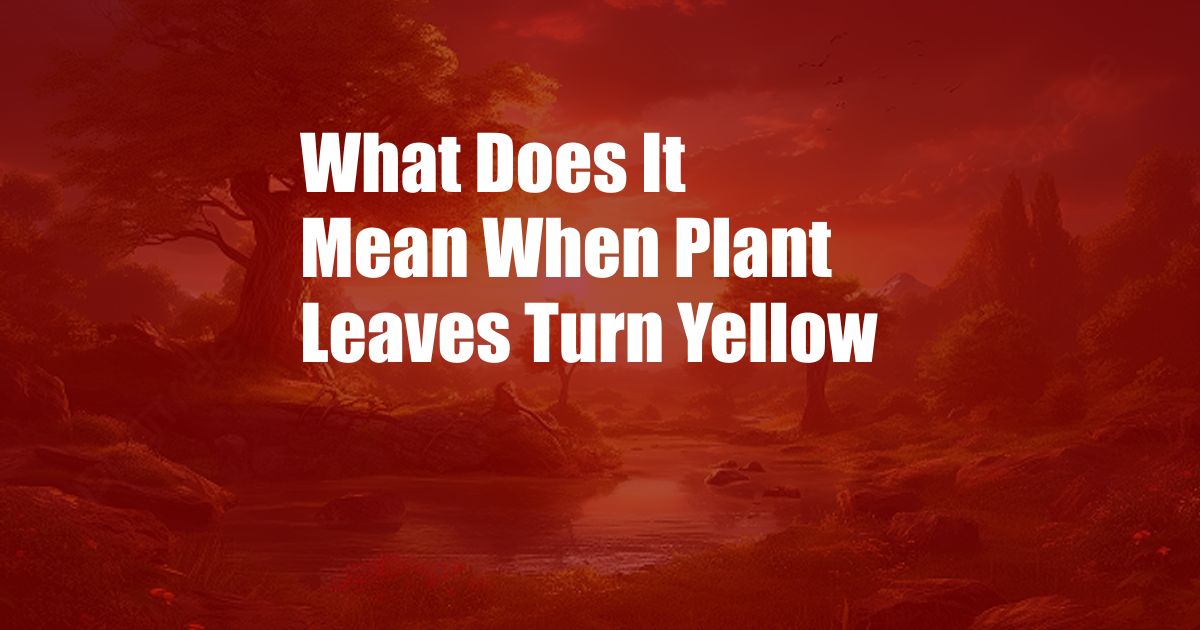
<h2>Yellowing Plant Leaves: A Sign of Health or Distress?</h2>
<p>Strolling through my lush garden, I noticed a peculiar sight – several plants with leaves slowly turning a vibrant yellow. A mix of curiosity and concern washed over me. Were they merely signaling the arrival of autumn or was something amiss?</p>
<p>Determined to unravel the mystery, I embarked on a journey to understand the hidden meaning behind yellowing plant leaves. Join me as I delve into the depths of this horticultural quandary, exploring the underlying causes, latest trends, and expert advice to shed light on this fascinating phenomenon.</p>
<h3>The Language of Leaves: When Yellow Speaks Volumes</h3>
<p>Leaves, the lifeblood of plants, serve as portals for photosynthesis, the vital process that converts sunlight into energy. As such, their color can often reveal the plant's overall health.</p>
<p>Chlorophyll, the green pigment that gives leaves their vibrant hue, is the key player in photosynthesis. However, when chlorophyll production slows down or breaks down, other pigments, such as carotenoids and xanthophylls, become more visible, giving rise to yellow, orange, and red shades.</p>
<h3>Causes of Yellowing Plant Leaves: A Multifaceted Perspective</h3>
<p>Yellowing leaves can be triggered by a myriad of factors, ranging from natural processes to environmental stressors:</p>
<ul>
<li><strong>Nutrient Deficiencies:</strong> Nitrogen and iron play crucial roles in chlorophyll production. A deficiency in either of these nutrients can result in yellowing leaves.</li>
<li><strong>Overwatering:</strong> Excessive watering can lead to root rot, which restricts water and nutrient uptake. This, in turn, can cause leaves to yellow and wilt.</li>
<li><strong>Underwatering:</strong> Conversely, underwatering can also cause leaves to turn yellow as the plant struggles to obtain water for photosynthesis.</li>
<li><strong>Sunlight Exposure:</strong> Intense sunlight can scorch leaves, causing chlorophyll to break down and leading to yellowing.</li>
<li><strong>Natural Aging:</strong> As plants age, chlorophyll production slows down, resulting in a gradual yellowing of leaves.</li>
</ul>
<h3>Latest Trends and Developments: Staying Abreast of Horticulture Advancements</h3>
<p>In the ever-evolving realm of horticulture, research sheds new light on the causes and management of yellowing plant leaves:</p>
<ul>
<li><strong>Genetic Variations:</strong> Studies have shown that certain plant varieties are more prone to yellowing leaves due to genetic predispositions.</li>
<li><strong>Environmental Factors:</strong> Climate change and pollution can exacerbate leaf yellowing by intensifying environmental stressors.</li>
<li><strong>Advanced Diagnostics:</strong> Novel technologies, such as chlorophyll fluorescence imaging, help identify nutrient deficiencies and other causes of leaf yellowing with greater accuracy.</li>
</ul>
<h3>Expert Advice: Nurturing Your Plant's Health</h3>
<p>Drawing from my experience as a gardener, I've gathered invaluable advice from experts to help you nurture your plants:</p>
<ul>
<li><strong>Regular Fertilization:</strong> Ensure your plants receive a balanced diet of essential nutrients, especially nitrogen and iron.</li>
<li><strong>Optimal Watering:</strong> Water your plants thoroughly, allowing the soil to drain well. Avoid overwatering or underwatering.</li>
<li><strong>Sunlight Management:</strong> Provide your plants with adequate sunlight, but protect them from scorching by providing shade during peak sunlight hours.</li>
<li><strong>Soil Testing:</strong> Conduct regular soil tests to determine nutrient levels and identify potential deficiencies.</li>
<li><strong>Disease Control:</strong> Monitor plants for signs of disease and take appropriate measures to prevent or treat infections.</li>
</ul>
<h3>FAQs: Demystifying Yellowing Plant Leaves</h3>
<p>Here are some frequently asked questions to address common concerns:</p>
<ol>
<li><strong>Q: Why do my leaves turn yellow in the fall?</strong>
<p>A: This is a natural process known as senescence, where chlorophyll breaks down and other pigments become more visible.</p></li>
<li><strong>Q: Is it always a problem when leaves turn yellow?</strong>
<p>A: Not necessarily. Mild yellowing can be a sign of nutrient deficiencies that can be easily remedied with fertilization.</p></li>
<li><strong>Q: Can overwatering or underwatering cause yellowing leaves?</strong>
<p>A: Yes, both improper watering practices can disrupt water and nutrient uptake, leading to leaf yellowing.</p></li>
<li><strong>Q: How can I prevent my leaves from turning yellow?</strong>
<p>A: Regular care, including proper fertilization, watering, sunlight management, and disease control, can help prevent yellowing leaves.</p></li>
</ol>
<h3>Conclusion: Unveiling the Meaning Behind Yellowing Plant Leaves</h3>
<p>The yellowing of plant leaves, whether a signal of natural processes or a cry for help, holds significant meaning for gardeners. By understanding the underlying causes, latest trends, and expert advice, we can nurture our plants and maintain their vibrant health.</p>
<p>I invite you to delve deeper into this fascinating topic and share your experiences with yellowing plant leaves. Let us continue to cultivate a deeper connection with the botanical world, where every leaf holds a story waiting to be unraveled.</p>
